Click here to see the rebuilding of our pond.
 ...From relining to replanting...
...From relining to replanting...

Our Sebastopol Pond's 18th year - 2013
aka THE YEAR OUR POND GOT REBUILT - page 2
Kathy's Bigsnest Pond Blog
January 2013 (this month records the rebuilding our pond)
Click here to see the rebuilding of our pond.
 ...From relining to replanting...
...From relining to replanting...

February 2013 (click on images to enlarge them, use your back button to return)
The pond settled in this month and very slowly, it is mid-winter after all, the plants started to grow.
The first 2 images below were taken on Valentine's Day. A little algae was forming, but that is perfectly natural and to be expected.
The water won't be clear until plant growth has achieved enuf volume to starve out the algae.
I LOVE MY POND!!


March 2013 (click on images to enlarge them, use your back button to return)
March meant Spring and plant growth, but, oh my, did we ever get algae!! But honestly, I wasn't worried; I knew that this was
normal and I share it with you to help fortify any of you when your new pond goes thru this stage! We still had the bird netting
around the edges to discourage raccoon and other critters from dislodging plants before they had rooted-in. These photos were taken March
third.
On the 11th, we took the bird netting out. We wished we'd done it sooner, as it was not only full of algae, but also the frogs
had attached their eggs to it....again, people aren't fond of the appearance of algae, but the critters don't feel the same!





We had some beautiful birds come in for drinks and a bath:
Bluebirds, Oak Titmouse, Golden-crowned and White-crowned Sparrows.




The emergent plants, esp. the Water Plantain, was, well emerging! It's to the right in the image below.
All the plants were doing so well, with the exception of the 5-finger ferns around the waterfall. It seems that with the waterfall
turned off for a whole month, with freezes that month, it got dry and died....will it come back? Check in in another few months
and we'll know!
I'm throwing in this one image, taken on the 20th that's linked image is larger than screen-size so you can 'investigate' it!
It really shows how the 5-finger ferns weren't growing...will they? You'll also note that the rope is still in place, holding
the horsetail onto the boulder. We wanted to wait about 3 months for that to 'root' together. The string algae was already
dying off, but the water wasn't clear yet.

Easter seemed extra sweet with the rejuvenation of the pond! We do feel it was 'resurrected'!
And, the water tastes GREAT, well, at least to the neighbor's cat Callie!
My plan to let the Water Plantain become the dominant plant, at first, because it was easy to save and over-winter, and a
also because it grows quickly was working. It was already several feet tall by Easter. Another idea that we were quite
pleased with was disguising the oak stump with a friend's beautiful pottery 'mask' and then planting our native
bleeding hearts under it, to signify love, of course! Spring rains were gentle, and everything was growing so well.



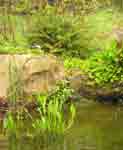


April 2013 (click on images to enlarge them, use your back button to return)
Pollywogs!! Yeah! It's been YEARS since pollywogs have been seen in the pond. In past years, we had frogs singing
and laying eggs, but never a pollywog hatched, unless I put eggs into an aquarium. So, I am REALLY happy! Also happy because,
pollywogs eat algae! And, we did note that the pond water was clearing while the Water Plantain was becoming
a forest!
I don't think I've talked about how important it is to have a pathway around your wildlife pond. It allows you to
access all the areas of the pond, and encourages not only your feet, but your eyes too to wander around the pond. In the
picture below, the sunny bog is just to the right of the walkway.
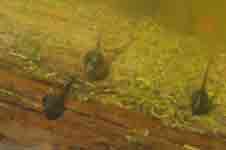


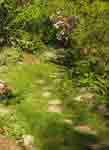
Some excitement on the pond on the 9th! For years and years I've suspected we had Beaverpond Baskettails (a species of dragonfly) come to the pond
in the Spring. But I could never be sure. This day, one not only did a fly by, but he passed back and forth repeatedly
so that I could get a few (lousy) pictures...but lousy as they were, they proved the identity. This is not only Ode species
#28, but a whole new family of ode for the pond. Baskettails are members of the Emerald family. If you have good eyes, you
might be able to pick out the emerald eyes in one of the photos. I added 2 images which show different views of the pond.



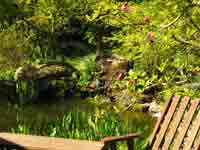

You never know where building a wildlife pond will lead you....I received a call from the "Record Searchlight" newspaper in
Redding, Calif. wanting to interview me about dragonflies (I'm the author of California's first Dragonfly Guide). And, they wanted
a picture of me by my pond....so Dave took several...and below is the one they used...HUGE! 5"X6" and in color!! Amd it was a
nicely done article...you never know! They titled it Dragons fly among us in the print version and
Call her dragonfly lady: Northern California woman wrote the book on colorful insects in the
on-line version. They even used a picture I'd taken at our pond of a
young male Cardinal Meadowhawk with the article! Yay!! And that's a double 'yay' because the Cardinal Meadowhawk's being back
on the pond is a triumpant event. They have been the dominant dragonfly on the pond since it's creation back in 1996.
Another Ode
(short for Odonata, the name of the scientific order that dragonflies and damselflies belong to) that make an appearance this month
is Common Whitetail (it's white doesn't show in this image!), and the Blue-eyed Darner. Aren't the Whitetail's wing veins pretty?
The Pacific Chorus Frogs were busy singing in the pond each night, calling for mates. One showed himself one
morning though. The water was still green-hued from algae, but every day we could see a little further into the depths.

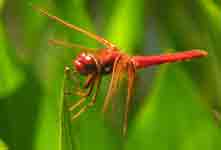

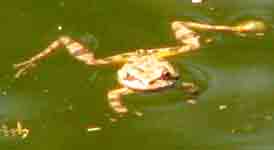
May 2013 (click on images to enlarge them, use your back button to return)
When we returned after spending 3 wks away on the East Coast, the pond was looking good, except for the pea-green water.
We were happy to have a Flame Skimmer holding a territory on the pond and then to see a
female Flame Skimmer come in and oviposit. This species lays eggs by splashing them up onto vegetation or rocks...to protect them from fish
(which we don't have) and other predators. Note how less colorful the female is than the male....this gives her better protection while
she oviposits. If you look closely at the image, you can see the flanges sticking out from the underside of the end of her abdomen that
she uses to make the splash. Luckily the real dragonflies aren't scared off by our whimsical dragonfly art!





I'm particulary happy about how the areas adjacent to the pond are looking. The native Wild Ginger behind the pond is looking
so lush, and the Sunny Bog area is full of blooms: Seep Monkeyflower, Douglas Iris, and Marsh Buttercup. These plants are all
native to California, where we live. And the butterflies are happy with things too! This American Lady butterfly visited the Scabiosa next to the pond's beach.




One thing I always promote is tying your pond in with the rest of your yard and home. It just looks so much more natural when you
do this. One idea I've used, after having seen a display years ago, is to use a large tub and place it within your patio pavers to make
it look like it has 'erupted' thru your patio. It's a little mind-trick that makes your created pond look more natural. I've had to
replant ours ever 6 years or so, and had done so last winter....the image to the left below shows how our tub full of horesetail
it is looking now after being replanted last winter.
Another way to tie your yard in with your pond is to have a potted water plant on a nearby area. This year ours temporarily housed
many plants we were saving overwinter while we emptied and relined the pond. It now hosts Water Plaintain.
The Water Plaintain in the pond is looking magnificent. I just cut back the flower stalks as they go to seed. I planted LOTS
of them this year as they are easy to grow and my plan is to thin them this winter...they naturally die back each winter anyway.A new
native plant for us to grow at the pond this year is Colt's Foot - it likes to have its 'foot' in the water. We're trying it out
right next to the waterfall....wonder if the Indian Rhurbard will shade it too much? I'm happy with how the 'planting pocket' I created
between the log edging and its fake 2nd log is filling in. In fact, I'm just very pleased with how all the edgings and plants are
growing...now if onlyl the water would clear up!!


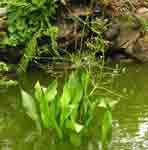



By the middle of May, dragonflies were everywhere over the pond...including some 'cooperative' guys that shared the dragonfly
perch I had put out for them. Dragonflies like to perch on a study branch near the edge of the pond. I have successfully used
manzanita branches for this purpose. They have beautiful twists and turns, dark bark and look much more graceful and natural than a straight bamboo
perch.Species in the photographs below (all are males as males come to the pond to claim territories and await females) include
Cardinal Meadowhawk, Flame Skimmer, and Common Whitetail.



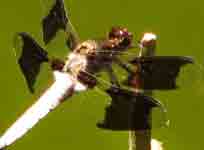





For beginners, it can be difficult to tell the Cardinal Meadowhawk and the Flame Skimmer apart. The first image
shows how you can use behavior to separate them. The Flame Skimmer always holds his wings out flat, like a biplane.
While the Cardinal Meadowhawk can do this when he first perches, he then cocks his wings downward and forward,
so, if you see this behavior, it is NOT a Flame Skimmer. The 2nd image shows the color difference and the different amount
of red in their wings.
The Common Whitetail is in the Skimmer family and also holds his wings out like a biplane. When young, the male looks a powdery
blue and as he matures he becomes gleaming white on the abdomen. It's easy to tell the Whitetail from the Cardinal.
In the 6th image, I just barely caught all 3 of these species on the perch....you have to look closely though to see the Cardinal
Meadowhawk in flight behind the Flame Skimmer. This is an unusual occurance in get 3 species in one shot!!
The last image in this set shows a pair of Cardinal Meadowhawks in
tandem...this is tandem guarding. The male is always the one in front. They have already mated and now he is protecting her while she
oviposits, making certain the eggs she lays are fertilized by his sperm. She'll be tapping her tail end in the water and
washing off from 12-300 eggs EACH time!!
We also have damselflies at the pond. Both dragonflies and damselflies are members of the order Odonata. The damsels
are much smaller and hold their wings folded over or alongside their abdomen. The males and females often look quite different
from each other, and the females even can change appearance dramatically as they mature. The photos here are of a mature
male and female Pacific Forktail. I think you can just make out the 'fork' on the upper tip of the male's abdomen,
the reason for the genus's common name.
One of the new emergent plants we've tried out just the past year or so is Bog-bean Menyanthes trifoliata..
I've read that it only grows above 3000', but it seems to be doing OK, and Bigsnest Wildlife Pond is at ~150'. Another dragonfly
that showed up mid-month is the very biggest one we can ever expect to find on our pond, the Pacific Spiketail. This one is a
male, so it doesn't have the spike on his tail, only the female has that! The Spiketail is almost as long as our Oak Titmouse
that likes to bathe in the 'bowl' of our waterfall rock. And, although he may look just as big in the thumbnail, the Long-jawed
Orb Weaver Spider is,
luckily, quite a bit smaller. What I wonder is how this species knows to arrive at the very time our damselflies start emerging from the
pond? I've also seen them building their orb webs over lake edges angled to best catch emerging damselflies. And, speaking of damsels,
Ode #28 showed up at the pond towards the end of the month, a male Familiar Bluet.




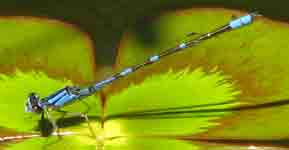
As we neared the half year mark on the remake of our pond, it was looking lush and providing habitat for wildlife....in other words,
doing what we planned! Yay!!
It is so wonderful seeing the Cardinal Meadowhawks busy ovipositing. We look forward to having
many emergers next year, you see, dragonflies spend about a year as underwater nymph before emerging as flying adults.


June 2013 (click on images to enlarge them, use your back button to return)
We decided that we actually had too much vegetation in the pond. We esp. like to have an area of clear water in the middle of the
pond, as we enjoy the reflections so. Some of the Plantain had to go! It was AMAZING how much growth their roots had put on already. They
were overflowing their pots from both the upper and lower openings!
One of the wildlife species that needs a pond to breed in is the Water Strider (aka the Walk-on-water bug). Usually we've seen them scavenging on the
pond surface. For years people have asked me if they didn't prey on our dragonflies, and I'd said "no". BUT, today I was admiring a
Western Forktail on a water clover leaf. I walked by, and came back that way just a moment or two later and found the strider eating
the Forktail! I don't know how common this is, but apparently they can take live prey! This happened on June 1st, and that very
same day we added a new insect to our pond visior's list - a June Bug. I don't believe they are really associated with ponds,
but how appropriate to have a June Bug show up on June 1st!!
The Common Whitetail and Flame Skimmer males delighted us by continuing to share our mazanita dragonfly perch.



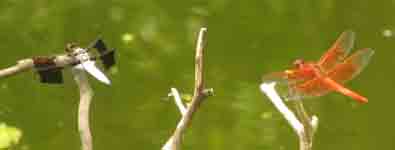
The dragonflies are the Kings of this pond (while the birds rule our Mt. Shasta pond). The Cardinal Meadowhawk and Flame Skimmer males also continued to share our mazanita dragonfly perch.
There is always a lot of drama at the pond. Mid-month we were delighted to find our pollywogs developing hind legs...but this one was
being eaten by a back swimmer. This is the first time we've witnessed this behavior. Then the next day we saw our first froglet.
It wasn't much larger than a fingernail, and with all the other drama on the pond, we wondered who would eat who as next to him was a
wolf-type spider....these spiders are able to 'skate' across a few feet of water, like the Water Striders do....but they always rush
back to shore and never seem too be 'at home' out on the pond vegetation. Each day we found more froglets. These 2 show how they can
be differently colored. I've read that they can change their color, but I'm not certain about this.





Have you noticed?????? The water is clearing up!! It took 6 months! But we never used any chemicals and totally relied on the pond
vegetation to filter out the excess nutrients and thereby starve out the algae! It really really DOES work!! Compare the two images of
Bog-bean - the one in May shows green water, while now the water is almost clear. But, this is sooooo funny....each picture, taken
weeks apart, shows a small male Pacific Forktail damselfly perched on the same leaf, with the same body orinetation!! The next photo
shows the main plant that filters our water, it is Elodea aka Goldfish Plant. It absorbs nuriants through its leaves
thus starving the algae....it just took it awhile to grow to enough mass to accomplish this. It gets sweet little white flowers if you
let it come to the surface. If you don't want it at the surface, you just use hedge-trimmers to cut it back.
The Sunny Bog on the far southern side of the pond (left in the photos) is full of flowering Seep Monkeyflower. The
bog is a nice hide-a-way for small critters coming to and from the pond, such as froglets. They can hide much better from predators
in the bog, as oppossed to a lawn. The next-to-last photo in this set is a female Pacific Forktail. She is fully mature and almost
devoid of markings.
Then on the 18th we had a real treat - a pair of Pacific Spiketails, the largest dragonfly what could
ever be expected to visit our pond, met. A male and a female. The male grabbed her by her eyes (that's the way the boys do it in
Odonata!) and she agreed to mate with him (it's up to the female, always). They flew to a raised mound we have next to the pond
and went into the 'wheel' position - the unique way dragonflies mate, while hanging from a penstamen flower! For over 20 mins, I sat next to them recording this behavior.
I was able to see how her spike (at the end of her abdomen) fit against the underside of his first segment. I'd always wondered how they
could accomodate that spike! Click on the last thumbnail in the set to see a whole set of images and a short video I captured.

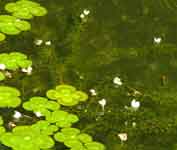



The pond ended the month with clear water and, for the first time ever, I brought folks from one of the workshops we teach to our pond!
It was a workshop on dragonflies, but everyone not only enjoyed the Odes, but they were interested in the concept of a wildlife pond. We have
a wildlife pond consultant business and I'm hoping there will be several new wildlife ponds constructed in Sonoma County this year! I was able
to show folks the exuvia of a darner on the flower stalk of one of the plantain plants.
The last shot in this sequence is just plain ODD - it was taken by our 'trail cam' and must have clicked just as it changed
from using daylight and color to infrared and black and white....or something!!




Our pond once had had Buckeye butterflies lay their eggs on our Mare's Tail that hatched and grew up and made chrysalsis all while on the Marestail in the pond
and that had been deemed so unusual that Art
Sharpiro (a CA butterfly expert/author) had it written up for a scientific journal. Well, lo and behold, this month I found a different
caterpillar on our Marestail. I sent the (poor quality) photos to Art, and this time we have the lovely White-lined Sphix Moth caterpillar.
Another unusual situation. The caterpillar isn't very pretty, and I never saw the moth, but here's a link to the
moth. This is Lepidoptera species #26 for the pond.
By the 23rd, the water was crystal clear. I mean, it couldn't have been more clear! We're just really happy with the
pond's rebirth....so is a Blue Dasher dragonfly. He was really catching the sun's rays when I clicked the camera to get his image.




July 2013 (click on images to enlarge them, use your back button to return)
We were only home for the first few days of July before we headed up to our other home in McCloud, CA for 7 weeks.
Believe me, that home has a pond too....I can't imagine living without one. Usually our pond brings us many living
things, but once in awhile, something chooses our pond to die in. That was the case with our Pale Swallowtail.
I'd been watching 2 of them 'dance' in the yard for days, then on the morning of the 6th, one was floating dead on the pond.
I imagine it became food for some of the other pond critters....probably not this darner nymph though. It would want live
food, although I've seen them eat pond snails, and they sure don't move fast enuf to appear alive at times.
The last image is a mature Pacific Forktail female. She starts out orange behind the eyes and then turns all dark. Very common
but not easy to identify as they have no markings. She is only about 1" long....dragonflies and damselflies don't grow at all once they emerge and become flying insects.



August 2013 (click on images to enlarge them, use your back button to return)
September 2013 (click on images to enlarge them, use your back button to return)
October 2013 (click on images to enlarge them, use your back button to return)
We returned to our Sebastopol home for the last few days of August. If you'd like to see our McCloud home's pond,
click on this link.These are last year's images. I haven't
gotten to putting up the images for 2013 yet.
I was concerned, we'd been gone SEVEN whole weeks. Our housesitters knew nothing about ponds. They were watering our plants, but not doing yard work.
So, no weeding. No 'babying'....what would it look like???? Well, it looked FANTASTIC!! It had clear clear water, was full of growth
and looked lush and inviting! The 'planting pocket' near the beach was a riot of color! The Scarlet Monkeyflower was
absolutely gorgeous! I'd never been able to grow it before! Mixed in with it were the white blooms of Arrowhead, yellow blooms of Seep
Monkeyflower and the lush green of all the leaves. Even Callie the Cat was happy! Cats prefer running water, and the pond's
'Frog Spitter Fountain' provides just that. After 7 weeks away, the pond did need to have the filter material cleaned, and man, the
liner was slippery. But just one hour in the pond, cleaning the filter and cutting back an entryway thru the vegetation and it was
'perfect' - the rest of the yard, well, that needed much more time for weeding, pruining, etc.
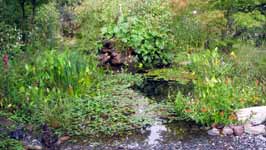

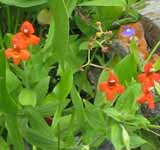
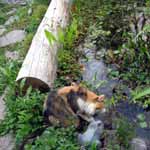
Fall means spiders, and this year was no exception, except that we had an exceptionally beautiful orb weaver Garden Argiope build her
web right near the pond. I haven't weeded that area all month, letting her and her web remain. She seems to be catching a lot of
honey bees in her web. We first saw her on the 3rd. She got fatter and fatter. Then on the 14th a mate showed up! He was SO much smaller
than her! He hung around 2 days, and when he left (on his own, or did she eat him?), she disappeared herself the next day. Finally she showed
up again a day later; she was much thinner. We assume she laid an egg sac, but we don't know where - maybe under the nearby deck.
Once before, a decade ago, we had
this same species of spider build her web in almost the exact same place. But when she laid her egg sac, she just put it right there on
her web and we were able to watch it develop. Open the pictures only if you dare!!




The weather was absolutely gorgeous all month and we ate both breakfast and dinner on the patio next to the pond all month.
Even the Cedar Waxwings thought so and came in for showers on the tree branches around the pond and then decided, when I turned
the sprinklers off, that a bath in the pond was in order. They put on quite a show and it was a lot of fun to watch them. And, although
I hate to think about it, it's about the end of the season for the Cardinal Meadowhawks. Soon they will all die, and only their eggs
and nymph will live on. This guy though was having fun pretending he was an X-wing fighter called 'Red Leader'!!



I tried a little 'pond dipping' on the 28th and brought up some of the seldom seen nymphs stage of our aquatic insects.
I found several aquatic beetle nymph, a few damelfly nymph and one darner nymph. I put them into a small
dish of water to photograph them....and luckily they were all more anxious to get back into the pond than hungry, so none of them ate
each other! It's not too surprising that aquatic beetles lay their eggs in the water, where they hatch and mature into beetles.
It's amazing, however, that the dragonflies and damselflies do! They actually live a year underwater before becomming flying adults.
The thin 6-legged guys with gills at their end are the damselfly nymph.
The multi-legged guys are the beetle nymph and the 6-legged bigger
guy is the darner nymph. Click on the links above to see their adult forms.




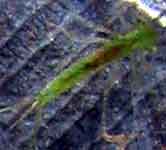

October is the month of change, of fall, of leaves falling into the pond and of the leaves growing out of the pond falling in to
become nurtriants for next year's growth. Not only does Ma Nature put on her new fall colors, but the bird and bug fauna at the pond completly
changes. One of the first 'new fall arrivals' was this young flicker who came into the waterfall for a drink. The # of Blue-eyed Darners
has dwindled steadily and now it's more likely that a darner on the pond will be a Shadow Darner. The Shadow knows...that it has
paired blue spots on the underside. They like to oviposit into saturated wood, and I worked hard to get this picture showing the blue
spots...had to shoot into the reflection....


Please come back soon, I'm adding information, commentary and images whenever I can!
Kathy
Return to the Bigsnest Wildlife Pond's entry page.
Thanks for visiting!
I always enjoy comments Kathy Biggs